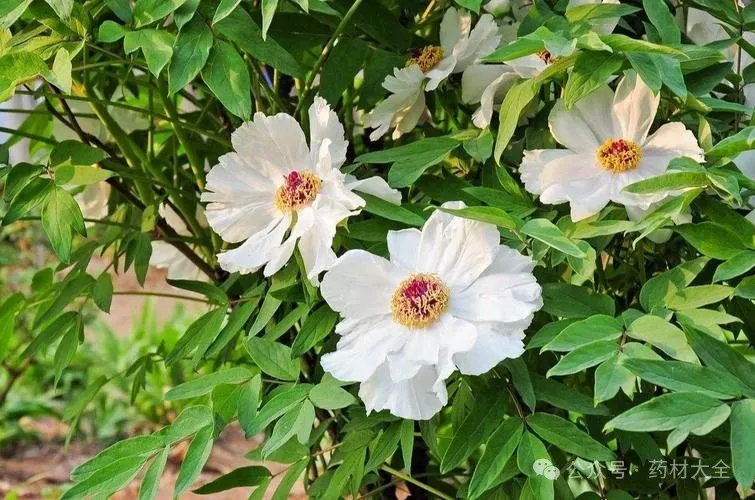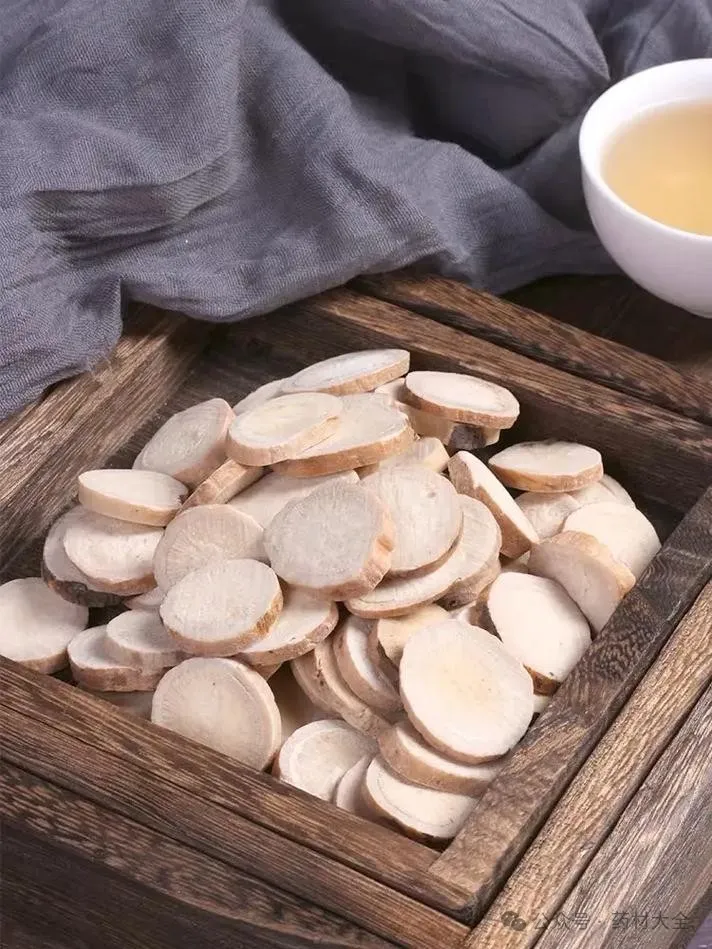Herb Encyclopedia
[Herb Name] Bai Shao (White Peony)
[Alias] Bai Shao Yao, Jin Shao Yao
[Category] Tonifying and Blood Nourishing Herbs
[Medicinal Part] The dried root of the plant is used. The best quality has a thick, straight root, firm texture, sufficient powdery quality, and a clean surface.
[Geographical Distribution] Grows in shrubs or grasslands on hillsides and in valleys. The main production areas are Zhejiang, Anhui, and Sichuan. Additionally, it is also found in Shandong, Guizhou, Hunan, Hubei, Gansu, Shaanxi, Henan, and Yunnan.
[Properties and Taste] Slightly cold, bitter, and sour. Enters the Liver and Spleen meridians.
[Functions] Nourishes blood, regulates menstruation, calms the liver, alleviates pain, astringes yin, and stops sweating.
[Indications] Yin deficiency with fever, headache and dizziness, irregular menstruation, pain in the chest, abdomen, and hypochondrium, limb cramps, diarrhea with abdominal pain, spontaneous sweating, night sweats, excessive menstrual bleeding, and leukorrhea.
[Pharmacological Components] Inhibitory effects on the central nervous system, vasodilatory effects. It has liver-protective, antispasmodic, and analgesic properties.
[Dosage] 6-15g, decocted for oral administration.
[Contraindications] Should not be used with Li Lu. Avoid in cases of cold abdominal pain and diarrhea, and during measles in children.
[Processed Bai Shao Effects]
Fried Bai Shao, also known as Zhi Bai Shao, is prepared by frying Bai Shao slices with wheat bran over low heat until slightly yellow with a few charred spots, then sieved and cooled for medicinal use.
Jiu Bai Shao, also known as Jiu Chao Bai Shao, is prepared by moistening Bai Shao slices with yellow wine, mixing well, and then frying until dry for medicinal use. This enhances its warming properties and blood-activating effects.
Cu Bai Shao, also known as Cu Chao Bai Shao, is prepared by spraying Bai Shao slices with rice vinegar and lightly frying over low heat for medicinal use. This is more focused on calming the liver, alleviating pain, nourishing blood, and stopping bleeding.
Jiao Bai Shao, also known as Jiao Shao or Bai Shao Tan, is prepared by frying Bai Shao slices over high heat until charred black, then extinguishing the fire with clean water and drying for medicinal use. This is more focused on stopping bleeding.
[Literature]
1. “Shennong Bencao Jing”: “Mainly treats abdominal pain due to evil qi, removes blood stasis, breaks up masses, treats cold and heat hernias, alleviates pain, promotes urination, and benefits qi.”
2. “Bielu”: “Unblocks blood vessels, alleviates pain, disperses stagnant blood, expels water, benefits the bladder and intestines, reduces swelling, treats seasonal cold and heat, and abdominal pain due to evil qi.”
3. “Rihua Zibencao”: “Treats wind and supplements consumption, mainly for all women’s diseases, and various ailments before and after childbirth, regulates menstruation, reduces fever and irritability, benefits qi, treats seasonal heat diseases, epidemic fevers, women’s blood circulation issues, intestinal wind bleeding, hemorrhoids, sores, headaches, improves vision, and treats red eyes and pterygium.”


[Compatible Formulas]
1. For postpartum blood qi attacking the heart causing abdominal pain: Bai Shao 60g, Gui Zhi (peel removed), Gan Cao (fried, crushed) each 30g. Mix these three ingredients, coarsely crush and sieve. Take 9g each time, boil with one cup of water until reduced to 70%, strain and take warm, without time restrictions. (“Pujifang” Shao Yao Decoction)
2. For women’s hypochondriac pain: Xiang Fu Zi 120g (with 2 bowls of yellow vinegar and 1 tael of salt, cooked until dry), Rou Gui, Yan Hu Suo (fried), Bai Shao Yao. Grind into a fine powder, take 6g each time, mix with boiling water, without time restrictions. (“Zhu Shi Ji Yan Yi Fang” Shao Yao Decoction)
3. For epistaxis and hemoptysis: Bai Shao 30g, Xi Jiao powder 0.3g. Grind into powder, take with water until bleeding stops. (“Gu Jin Lu Yan”)
4. For dysmenorrhea: Bai Shao 60g, Gan Jiang 24g. Grind into a fine powder, divide into eight packets, take one packet daily during menstruation with yellow wine, continue for three weeks. (“Inner Mongolia” New Medical Method Compilation)
5. For bleeding from traumatic injuries: Bai Shao 30g, fry until yellow, grind finely into powder. Take 6g with wine or rice wine. Start with three doses, gradually increase. (“Guang Li Fang”)
6. For edema and pain from beriberi: Bai Shao 180g, Gan Cao 30g. Grind into powder, take with white soup. (“Sui Shi Guang Ji”)
7. For dysentery with pus and blood, urgency, and heaviness: Shao Yao 30g, Dang Gui 15g, Huang Lian 15g, Bing Lang, Mu Xiang 6g; Gan Cao 6g (fried), Da Huang 9g, Huang Qin 15g, Guan Gui 7.5g. Finely chop, take 15g each time, boil with two cups of water until reduced to one cup, take warm after meals. (“Suwen Bing Ji Bao Ming Ji” Shao Yao Decoction)
8. For abdominal pain during pregnancy: Dang Gui 90g, Bai Shao 480g, Fu Ling 120g, Bai Zhu 120g, Ze Xie 240g, Chuan Xiong 150g. Grind into powder, take with wine three times a day. (“Jin Kui Yao Lue” Dang Gui Bai Shao San)
Differences Between Chi Shao and Bai Shao:
Bai Shao nourishes blood, regulates menstruation, calms liver yang, and astringes yin to stop sweating. It is commonly used for liver blood deficiency, pale complexion, dizziness, palpitations, irregular menstruation, excessive menstrual bleeding, headaches and dizziness due to liver yang rising, and sweating due to wind-cold with disharmony of Ying and Wei.
Chi Shao clears heat and cools blood, invigorates blood and disperses stasis, and clears liver fire. It is commonly used for warm toxin rashes, blood heat causing epistaxis, heat toxin accumulation, carbuncles and sores, and liver fire causing red, swollen, and painful eyes.
Commonalities Between Chi Shao and Bai Shao:
Both Chi Shao and Bai Shao can alleviate pain.
Bai Shao is better at softening the liver to relieve pain, often used for chest and abdominal pain due to liver-spleen disharmony or limb cramps.
Chi Shao is better at invigorating blood and dispelling stasis to relieve pain, often used for hypochondriac pain due to liver qi stagnation, blood stasis dysmenorrhea, abdominal pain from masses, traumatic injuries, and swelling pain.

Source: Herb Encyclopedia
Scan to follow us
 Shuozhou Traditional Chinese Medicine Hospital WeChat Subscription Account
Shuozhou Traditional Chinese Medicine Hospital WeChat Subscription Account
 Shuozhou Traditional Chinese Medicine Hospital WeChat Official Account
Shuozhou Traditional Chinese Medicine Hospital WeChat Official Account
 Pingshu HospitalWeChat Official Account
Pingshu HospitalWeChat Official Account

